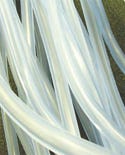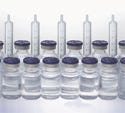Wireless data collected directly from patients during normal physical activities could enable the development of better knee implants
October 7, 2008
Originally Published MPMN October 2008
SPOTLIGHT
Plastics and Elastomers
Liquid silicone rubber
|
A line of liquid silicone rubbers (LSRs) has been developed for use in short-term implantable devices designed for contact with the body for up to 29 days. In addition, the materials are suitable for disposable applications in IV sets and catheters, as well as for a variety of components, including valves and O-rings. With chemistry similar to that of the supplier’s existing LSRs, the S40, S50, and S70 LSRs also incorporate most of the same polymers but optimize the chemistry from a molecular level in order to achieve a stronger, more-consistent material. The company maintains that this series of materials attains its ultimate physical properties upon initial cure with no drift.
Dow Corning, Midland, MI
www.dowcorning.com
Medical elastomers
|
Consisting of 30 different material options, a family of high-purity thermoplastic elastomers does not contain animal-derived materials, vinyl, phthalates, latex, or any additives that are not required for medical applications. The Medalist series of elastomers encompasses compounds that are designed to be versatile as well as heat and chemical resistant. Products formulated for overmolding can adhere to various substrates. The supplier of the TPEs offers product support to device designers in the form of test data, design and processing guidelines, property tables, and regulatory compliance information.
Teknor Apex Co., Pawtucket, RI
www.teknorapex.com
Conductive thermoplastics
|
Blending polycarbonate and acrylonitrile butadiene styrene thermoplastic polymer alloys with conductive fillers has yielded a conductive thermoplastic that exhibits EMI shielding up to 85 dB. To obtain an evenly dispersed fiber matrix within the polymer, fibers are treated with a proprietary dispersion agent technology, resulting in uniform shielding throughout a complex part’s geometry. Unlike with many traditional shielding products, parts molded using Premier plastics do not require secondary operations—a characteristic that the material’s supplier claims can cut costs in half compared with die castings, bent-formed metal, or coated nonconductive plastics. Weighing less than metal in some cases, the material can be used for handheld devices.
Chomerics, div. of Parker Hannifin Corp., Woburn, MA
www.parker.com/chomerics
Specialized thermoplastics
|
A plastics provider has unveiled a portfolio of engineered polymer materials that comprise both thermoplastic elastomers and engineering thermoplastic compounds. Customizable, the Trilliant HC family is suited for use in structural, antimicrobial, surface engineering, conductive and antistatic, thermal management, precolored, and flame-retardant applications. Within this family of products, PbF specialty materials are lead-free polymer-metal composites engineered to replace lead in diagnostic equipment and CT scanners. The materials have demonstrated shielding efficacy that is equal to or better than lead, according to the supplier.
PolyOne Corp., Avon Lake, OH
www.polyone.com
Cycloolefin polymers
|
Suited for parenteral packaging applications, a line of cycloolefin polymers (COPs) can be molded to obtain various sizes of prefilled syringes, pen injector cartridges, vials, and bottles. Characteristics of Zeonex COPs include low water absorption, chemical resistance, and high transparency of 92% in the visible range of 400 to 800 nm, which allows easy visual checks of drug level and quality. Tougher than COC plastics, COPs are less prone to breakage during molding operations and are lighter and easier to handle than glass, according to the material supplier. The materials can withstand steam, EtO, and gamma sterilization.
Zeon Chemicals, Louisville, KY
www.zeonex.com
Soft liquid silicone rubber
|
A raw-materials manufacturer has introduced a line of low-durometer soft liquid silicone rubber (LSR) products for healthcare applications. The Silbione line of LSRs offers strong physical attributes and can be processed at Shore A hardnesses of 05, 10, and 25. With a Shore A hardness of 10, LSR 4310 provides higher elongation and 50% greater tear strength than competing products, while 25-durometer LSR 4325 features high tear strength, elongation, and resiliency, according to the supplier. These properties make the latter material suitable for stretch-and-return applications such as balloon catheters. LSR 4305 has tacky gel-like features for use in cushioning products.
Bluestar Silicones, East Brunswick, NJ
www.bluestarsilicones.com
Copyright ©2008 Medical Product Manufacturing News
You May Also Like








